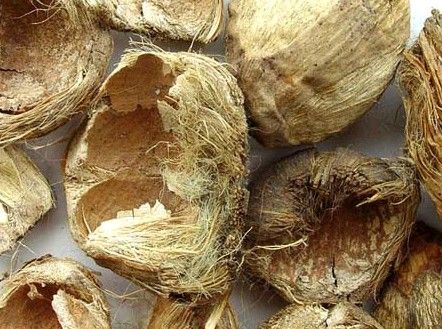Also known as areca peel, it refers to the dry peel of Areca catechu L., a member of palmae plants. Medicinally the immature fruits are usually harvested from winter to spring. And then the fruits are boiled and dried. After that they are sliced in half longitudinally and the peel is stripped. And this herb contains a small amount of arecoline and catechins.
PHARMACOLOGY
1. This herb excites gastrointestinal smooth muscle. The decoction of areca peel can increase the tension of intestines isolated from rabbit. That being said, the contraction of the rabbit's smooth muscle decreases. And its role could be antagonized by atropine.
2. This herb promotes gastrointestinal motility.
3. This herb promotes fibrinolysis.
POPULAR ARECA PEEL RELATED HERBAL FORMULAS
In accordance with the theory of Traditional Chinese Medicine (TCM), betel husk is acrid and slightly warm in properties. It covers 4 meridians, such as spleen, stomach, large intestine, and small intestine. Its principal functions are to relieve stagnation in middle burner by descending Qi and promote urination to reduce swelling. Its main uses and indications are retention of dampness and stagnation of Qi, epigastric distension and Depression, discomforting evacuation, swelling in Edema, puffiness due to beriberi, and dysuria. Recommended dosage is from 5 to 10 grams in decoction. It can be used in the forms of pills or powder too.

Betel Husk
1) Da San Wan San
Da San Wan San comes from Chuan Jia Mi Bao Fang (The Heirloom Secret Recipes). This formula is mainly used for reversed flow of Qi in tri-jiao, constipation, and fullness chest and hypochondrium. Other main herbs include Zi Su Ye (Perilla Leaf), Bing Lang (betel nut), Chen Xiang (Agarwood), Mu Gua (Quince Fruit), Chuan Xiong (Ligusticum), and so on.
2) Wu Ai Wan
Wu Ai Wan is from Su Shen Liang Fang (The Effective Prescriptions of Su and Shen). This prescription is primarily used for dyspnea accompanied with swelling limbs and excessive dampness due to dysfunction of spleen. Other major herbal ingredients are E Zhu (Zedoaria Rhizome), San Leng (Scirpus Rhizome), Bing Lang (betel nut), and Mu Xiang (Costus Root).
3) Mu Gua San
Mu Gua San comes from Chuan Jia Mi Bao Fang too. It is mainly formulated for invasion of beriberi into the heart (myocarditis due to deficiency of vitamin B1) and dysphoria in chest and diaphragm. Other key herbs include Zi Su Ye, Gan Cao (Licorice Root), Mu Xiang, and Qiang Huo (Notopterygium).
And other famous ancient formulas include Wu Pi Yin from Ma Ke Huo Ren Quan Shu (Complete Life-saving Book on Measles), Da Fu Pi San from Tai ping sheng hui fang (Taiping Holy Prescriptions for Universal Relief), Da Fu Zi San from Chi Shui Xuan Zhu (Pearls of Wisdom Retrieved from the Crimson Sea), and so on.

![Diseases, Symptoms, tcm, [tcmwindow.com]](/uploadFile/adImg/2015/11/11/f5cbfcc0-4df5-4646-9b9a-f316651a0199.jpg)





